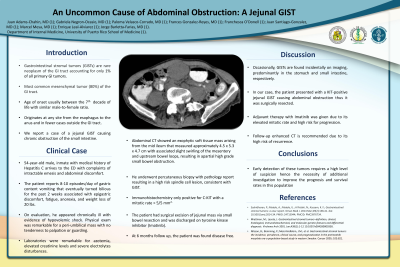Back


Poster Session C - Monday Afternoon
Category: Small Intestine
C0650 - An Uncommon Cause of Abdominal Obstruction: A Jejunal GIST
Monday, October 24, 2022
3:00 PM – 5:00 PM ET
Location: Crown Ballroom

Has Audio

Juan J. Adams Chahin, MD
University of Puerto Rico Medical Sciences Campus
San Juan, PR
Presenting Author(s)
Juan J. Adams Chahin, MD1, Gabriela M. Negron-Ocasio, MD1, Paloma Velasco, MD2, Frances A. Gonzalez Reyes, MD2, Fransheska O'Donnell, MD3, Juan C. Santiago-Gonzalez, MD1, Marcel Mesa, MD4, Enrique Leal Alviarez, MD3, Jorge Barletta Farias, MD3
1University of Puerto Rico Medical Sciences Campus, San Juan, Puerto Rico; 2University of Puerto Rico, Internal Medicine Program, San Juan, Puerto Rico; 3University of Puerto Rico Hospital, San Juan, Puerto Rico; 4University of Puerto Rico School of Medicine, San Juan, Puerto Rico
Introduction: Gastrointestinal Stromal Tumors (GISTs) are rare neoplasm representing only 1% of all primary GI tumors. Yet they are the most common mesenchymal tumor (80%) of the GI tract with an age of onset usually between the seventh decade of life and a similar male-to-female ratio. GISTs can originate at any site from the esophagus to the anus and in fewer cases outside the GI tract. Therefore, having a wide range of presentation from asymptomatic to signs of acute abdomen. We report a case of a jejunal GIST causing chronic obstruction of the small intestine.
Case Description/Methods: Case of a 54-year-old male, inmate with medical history of Hepatitis C arrives to the emergency department with complaints of intractable emesis and abdominal discomfort. The patient reports 8-10 episodes/day of gastric content vomiting that eventually turned bilious for the past 2 weeks. Furthermore, he refers having epigastric discomfort associated with fatigue, anorexia, and weight loss of 20 lbs since approximately 2 months ago. The patient denied any family history of gastrointestinal disease. On evaluation, he appeared chronically ill with signs of hypovolemic shock. Physical exam was remarkable for a peri-umbilical mass with no tenderness to palpation. Abdominal CT showed an exophytic soft tissue mass arising from the mid ileum that measured approximately 4.5 x 5.3 x 4.7 cm with associated slight swirling of the mesentery and upstream bowel loops, resulting in transition point and upstream dilatation of the small bowel compatible with a partial high grade small bowel obstruction. He underwent percutaneous biopsy with pathology report resulting in a spindle cell lesion, high risk, most consistent with GIST. Immunohistochemistry was only positive for C-KIT with a mitotic rate > 5/5 mm2. The patient had surgical excision of jejunal mass via small bowel resection and was discharged on tyrosine kinase inhibitor. At 6 months follow up, the patient was found disease free.
Discussion: Occasionally, GISTs are found incidentally on imaging, predominantly in the stomach and small intestine, respectively. In our case, the patient presented with a KIT-positive jejunal GIST causing abdominal obstruction. Neoadjuvant therapy with Imatinib was given due to its elevated mitotic rate and high risk for progression. Early detection of these tumors requires a high level of suspicion hence the necessity of additional investigation to improve the prognosis and survival rates in this population.
Disclosures:
Juan J. Adams Chahin, MD1, Gabriela M. Negron-Ocasio, MD1, Paloma Velasco, MD2, Frances A. Gonzalez Reyes, MD2, Fransheska O'Donnell, MD3, Juan C. Santiago-Gonzalez, MD1, Marcel Mesa, MD4, Enrique Leal Alviarez, MD3, Jorge Barletta Farias, MD3. C0650 - An Uncommon Cause of Abdominal Obstruction: A Jejunal GIST, ACG 2022 Annual Scientific Meeting Abstracts. Charlotte, NC: American College of Gastroenterology.
1University of Puerto Rico Medical Sciences Campus, San Juan, Puerto Rico; 2University of Puerto Rico, Internal Medicine Program, San Juan, Puerto Rico; 3University of Puerto Rico Hospital, San Juan, Puerto Rico; 4University of Puerto Rico School of Medicine, San Juan, Puerto Rico
Introduction: Gastrointestinal Stromal Tumors (GISTs) are rare neoplasm representing only 1% of all primary GI tumors. Yet they are the most common mesenchymal tumor (80%) of the GI tract with an age of onset usually between the seventh decade of life and a similar male-to-female ratio. GISTs can originate at any site from the esophagus to the anus and in fewer cases outside the GI tract. Therefore, having a wide range of presentation from asymptomatic to signs of acute abdomen. We report a case of a jejunal GIST causing chronic obstruction of the small intestine.
Case Description/Methods: Case of a 54-year-old male, inmate with medical history of Hepatitis C arrives to the emergency department with complaints of intractable emesis and abdominal discomfort. The patient reports 8-10 episodes/day of gastric content vomiting that eventually turned bilious for the past 2 weeks. Furthermore, he refers having epigastric discomfort associated with fatigue, anorexia, and weight loss of 20 lbs since approximately 2 months ago. The patient denied any family history of gastrointestinal disease. On evaluation, he appeared chronically ill with signs of hypovolemic shock. Physical exam was remarkable for a peri-umbilical mass with no tenderness to palpation. Abdominal CT showed an exophytic soft tissue mass arising from the mid ileum that measured approximately 4.5 x 5.3 x 4.7 cm with associated slight swirling of the mesentery and upstream bowel loops, resulting in transition point and upstream dilatation of the small bowel compatible with a partial high grade small bowel obstruction. He underwent percutaneous biopsy with pathology report resulting in a spindle cell lesion, high risk, most consistent with GIST. Immunohistochemistry was only positive for C-KIT with a mitotic rate > 5/5 mm2. The patient had surgical excision of jejunal mass via small bowel resection and was discharged on tyrosine kinase inhibitor. At 6 months follow up, the patient was found disease free.
Discussion: Occasionally, GISTs are found incidentally on imaging, predominantly in the stomach and small intestine, respectively. In our case, the patient presented with a KIT-positive jejunal GIST causing abdominal obstruction. Neoadjuvant therapy with Imatinib was given due to its elevated mitotic rate and high risk for progression. Early detection of these tumors requires a high level of suspicion hence the necessity of additional investigation to improve the prognosis and survival rates in this population.
Disclosures:
Juan Adams Chahin indicated no relevant financial relationships.
Gabriela Negron-Ocasio indicated no relevant financial relationships.
Paloma Velasco indicated no relevant financial relationships.
Frances Gonzalez Reyes indicated no relevant financial relationships.
Fransheska O'Donnell indicated no relevant financial relationships.
Juan Santiago-Gonzalez indicated no relevant financial relationships.
Marcel Mesa indicated no relevant financial relationships.
Enrique Leal Alviarez indicated no relevant financial relationships.
Jorge Barletta Farias indicated no relevant financial relationships.
Juan J. Adams Chahin, MD1, Gabriela M. Negron-Ocasio, MD1, Paloma Velasco, MD2, Frances A. Gonzalez Reyes, MD2, Fransheska O'Donnell, MD3, Juan C. Santiago-Gonzalez, MD1, Marcel Mesa, MD4, Enrique Leal Alviarez, MD3, Jorge Barletta Farias, MD3. C0650 - An Uncommon Cause of Abdominal Obstruction: A Jejunal GIST, ACG 2022 Annual Scientific Meeting Abstracts. Charlotte, NC: American College of Gastroenterology.
